|
Click on pictures for larger view
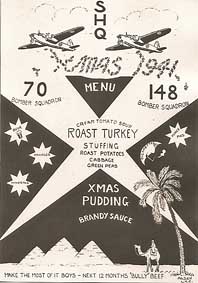
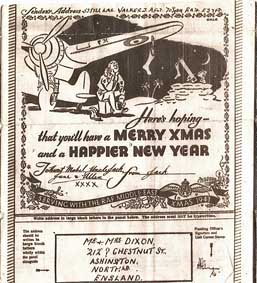
|
On 12th May,1941, the three plane detachment returned to Kabrit and a quieter life for a few days at least, because on 17th May, he made a diary entry – ‘ We had an air raid here tonight. Two enemy aircraft shot down outside Ismailia.’
The squadron returned to the routine of harassing the Germans in north Africa and was also involved in the campaign to conquer Vichy occupied Syria, targeting convoys, supply dumps and airfields. Christmas 1941 was spent at Kabrit together with 148 Squadron, see the camp’s Christmas menu, and an airgram which Jack sent to his aunt and uncle, showing he was attached to ‘A’ Flight.
|
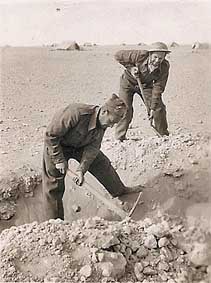
|
70 Squadron relocated frequently in support of the British Army and
its Allies , life in the desert being quite rough and dangerous, having to dig into the hard ground for a little bit more protection from enemy attack. See George Pinnick facing camera and the Welshman digging in, also one of George
Pinnick, one of Jack standing centre, Jim Baldwin standing 1st left and George Pinnick kneeling on right, the others are unknown.
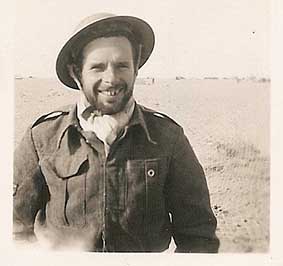
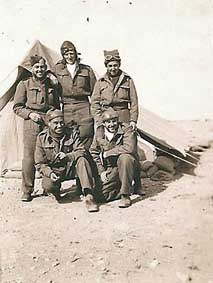
|
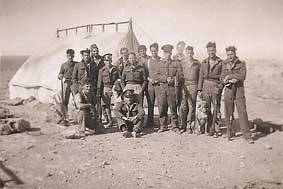
|
The next photo contains fifteen men standing: 3rd left is the Welshman, 4th left in shorts and Italian
officer’s hat is Shorty Martin and 3rd from right in back row is Matthew
Loughlin, the others remain unknown. There were eight men to a tent. One day after a flight test
F.O. Dick fooling around flew so low over Jack’s tent he knocked the wooden cap off the top of the tent pole.
|
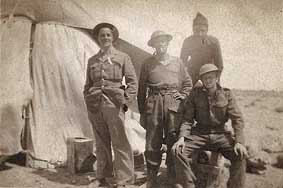
1.
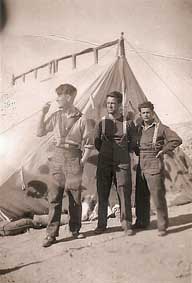
2.
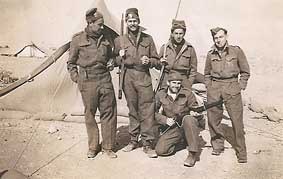
3. |
By January,1942, the squadron had left Kabrit and was back in the Libyan desert at ALG 75, and by the end of the month it was at ALG 104. They were to remain here for about three months. It was here that Jack had just passed two armourers preparing 500 lb. bombs. They were fitting detonators of a type which were booby-trapped to beat the enemy. They worked on the principle they would not explode on impact, but when anyone tried to remove the detonator it would explode after four seconds. One of the men had fitted a detonator and was sitting astride it when his colleague, a young sergeant, walked up to the one he had just fitted and proceeded to remove the cap to fit the detonator, not realising it had already been fitted. He realised too late and the
ensuing explosion killed both men, two men on a petrol bowser and it also caused secondary explosions in a fully armed Wellington being refuelled close by, killing all four crew and three out of four of the refueling team.
Only five minutes earlier Jack had walked by the plane and bombs whilst on his way to the cook-house and spoke to the armourers. On hearing the explosions he and others jumped under a
trestle table in the tent where they were eating – a futile gesture but they had nowhere else to shelter. The fourth member of the refueling crew escaped by running along the wing and jumping off the end. One of the sergeants who was killed realised what was happening and warned the other. The two sergeant armourers killed had been to Athens with Jack.
Airmen
killed in this accident, Wellington Z9023, 27/2/42 (70 Squadron
Summary of Events, February, 1942):
567978
F/Sgt G. Malpass, F/Armr. 533293 Sgt A. Stringfellow,
Armr.
627076 LAC R.R. McClean F/Mech A
1107100
LAC S. Jarvis, ACH/G.D.
957465 LAC A. Hopewell,
M/Cyclist
On another occasion at ALG104, he was sitting astride the central wing spar in the Wellington eating his lunch – a tin of corned beef, whilst F/O Dick was in the Officer’s Mess, when he heard an aeroplane approaching. It was a murky day with very low cloud. He looked out and saw a four-engine German Condor bomber flying straight at him. He ran for his life, his legs felt like lumps of lead, but the Germans ignored him and the Wellington even though it was in direct firing line and dropped all
its bombs on the water works and tanks at the edge of the base at the railhead.
Three more photos of his time in the desert where there was nothing to do in one’s spare time bar take a few
photos:
1. Jack is seated and wearing a helmet.
2. Matthew Loughlin is on the left.
3. Jim Baldwin is on the right and George Pinnick is right front.
|
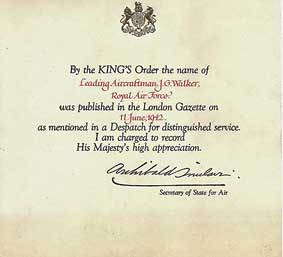
|
On 12th June, 1942, Jack was Mentioned in Despatches and his name published in the London Gazette. He refused to reveal to the family the reason why. I believe it was for an act of valour in the face of the enemy. I doubt we will ever know.
ALG 104 was frequently attacked by the Germans. During one such attack Jack and a friend were seated on the edge of a slit trench watching the Germans bomb the other side of the landing ground when suddenly a piece of shrapnel whistled through the gap between them. Needless to say they soon dropped down into the trench.
During his last night there the Germans caught the camp off guard.
A rear gunner caught him in his sights and bullets were kicking up the dust around him - a close encounter. It was a clear bright night, fortunately no aircraft were hit, but an Italian P.O.W. was killed by a bomb blast as he ran away. He used to work in the Officers Mess.
|
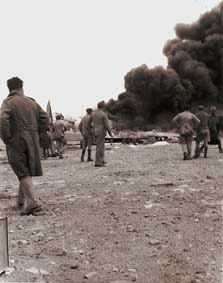
|
70 Squadron had to evacuate ALG 104. They found temporary relief at ALG 60 for a few days, before relocating to Abu
Sueir, Egypt. After three months in the desert they could at last take a bath and sleep in a proper bed. From here the squadron resumed their raids on the enemy.
On 18th August,1942, a disaster occurred at the base. Jack’s account of what happened is as follows:-
A young South African pilot flying an American Martin Maryland twin engine bomber on a practice flight, struck a barrage balloon cable over Ismalia and had to make an emergency landing. In doing so, he landed with the wind, not against it. He was unable to stop the aircraft and it careered on and into a Wellington bomber – the end aircraft of a line of Wellingtons bombed up and awaiting take-off. There was a terrific explosion killing the South African pilot and the crew of five aboard the Wellington. At least three or four other aircraft were also destroyed as one by one the fire spread from the initial crash and their bombs exploded. See photo of the carnage.
During this incident his Pay Book was in a tent set on fire by the explosions. Together with others it was rescued. I now possess this charred book. Jack was about 200 yards away from the explosions and had to dive into a trench near his billet to escape debris which was flying
everywhere. He remembered a propeller blade being blown over the slit trench he was in.
It was hours later before the last of the bombs exploded and the fires were extinguished.
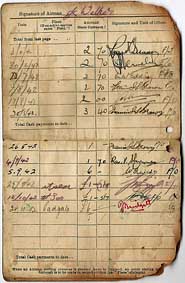

|
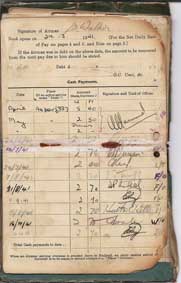
|
Here are a few more pages in his Pay Book showing the currency in the Amount column. On 24.12.40 he was paid in
"Drakmas"(sic) in Greece. Then in May,1941, it changed again. Tucked away in the rear of the book is an old 50 lira Italian note, kept probably for a rainy day!
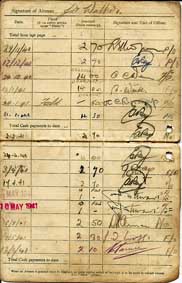
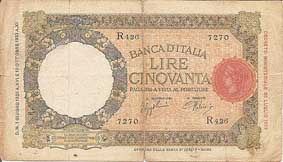
|
1. 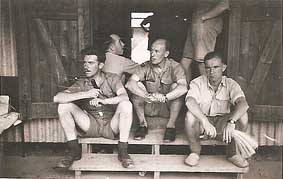
2. 
3. 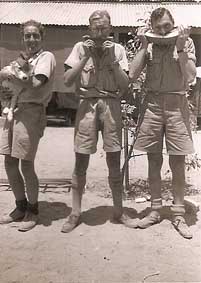
|
Jack spent roughly ten weeks at Abu Sueir before being repatriated to the UK - he had been abroad for over three and a half years and was in dire need of home leave.
Before departing he took several photos of his colleagues.
1. Believed to be of Sgt. Hardisty seated first left, with possibly Danny Hanton seated centre, the others are unknown.
2. Corporal ‘Yosser’ Hughes.
3. ‘Yosser’ Hughes, Ted Wallace and unknown.
4. Possibly Ted Wallace standing first left. with ‘Yosser’ Hughes kneeling first right.
5. He also posed for one or two photos of himself, patiently waiting before departure.
4. 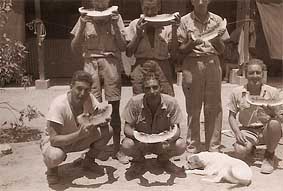 5.
5. 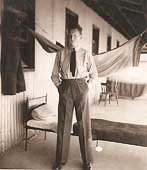
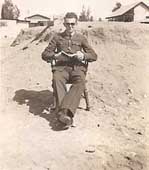
|
|
|
On 6th September, 1942, he embarked aboard the ‘Windsor Castle’, at Port Suez, Egypt, to sail home via South Africa and the Atlantic Ocean( this meant he missed the Squadron photograph which was taken on the 15th September at Abu
Sueir). The ‘Windsor Castle’ also had on board 700 Italian POWs who were taken off at Port Elizabeth. The ship then continued on to Cape Town where he spent his 24th Birthday on 2nd October, 1942. The day after it departed for home.
He disembarked at Gorack on the River Clyde, Scotland on 10th October. He then had to report to RAF Padgate to hand in his overseas kit before being allowed to take two weeks leave at home with his parents and three younger sisters at
Ashington, Northumberland.
|
|
|
|
|
|
|
|
|
|
|
|
1
2 3
5
|
|
|

